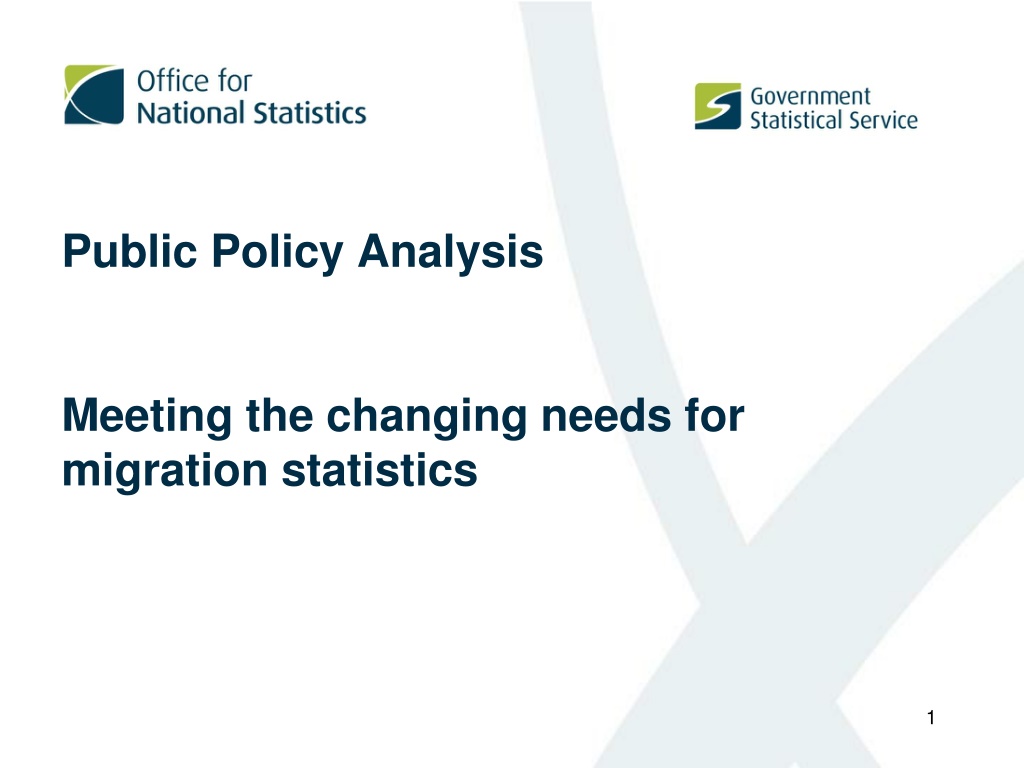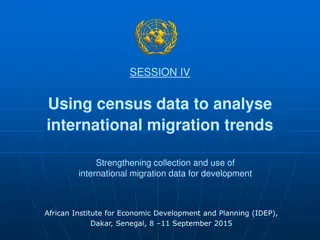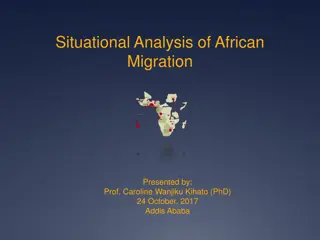Meeting the Changing Needs for Migration Statistics
Building on the Government Statistical Service's efforts to enhance evidence collection and analysis on migration, there is a shift towards understanding the impact of migration on the economy and society. The changing policy context, particularly influenced by Brexit negotiations, emphasizes considerations such as labor market effects, access to services, and housing availability. Utilizing administrative data sources and collaborating across government departments are key strategies to improve the evidence base on migration in 2019.
Download Presentation

Please find below an Image/Link to download the presentation.
The content on the website is provided AS IS for your information and personal use only. It may not be sold, licensed, or shared on other websites without obtaining consent from the author. Download presentation by click this link. If you encounter any issues during the download, it is possible that the publisher has removed the file from their server.
E N D
Presentation Transcript
Public Policy Analysis Meeting the changing needs for migration statistics 1
Building our migration knowledge The Government Statistical Service has been iteratively improving our evidence base and outputs to aid understanding over the last few years, for example: o Labour market characteristics of migrants April 2017 o Housing May 2017 o Living Abroad series July 2017 o Student migration August 2017 o Improved communication of migration messages Demand for evidence is now more on the impact of migration on the economy and society rather than how it contributes to population change. 2
Migration Statistics Framework Who are migrants? 3
The policy context that our work sits in is changing Brexit negotiations and implications for European migration. Impact on labour market and macro-economy (wages, growth and skills) Access to benefits and services o Health services o School places Impact on housing availability and affordability Student migration and higher education sector o Migration Advisory Committee Impact of international students in the UK. Public Administration and Constitutional Affairs Committee Parliamentary interest 4
Our ambition is to use administrative sources at the core of evidence on migration in 2019 Migrants interact with government in lots of different ways, giving us a great opportunity for change. The Digital Economy Act (DEA) provides us a way to access these data and crucially link them together. Within the Government Statistical Service we have great expertise to help build a government wide collaborative approach to using this administrative data. The DEA powers positions us well to work across government to build an evidence base for the common good. Key priority data sets include: o Exit Checks, Self-Assessment data, PAYE Real Time Information. o Working with experts in other government departments will be vital to build on their expertise. 5
The continuing role of the International Passenger Survey (IPS) Administrative data provide new information to inform debate on migration. The IPS retains a vital role, as a leading indicator of migration patterns. Both systems will be used in a complementary way to give the fullest picture possible. 6
Timeline of planned work Date Topic Additional Admin data sources Late 2017 Work & Family visa analysis providing better evidence on travel and migration patterns of non-EU nationals Exit Check data 2018 EU Nationals travel and migration patterns How do EU citizens interact with administrative systems in the UK and what can we learn about their movements, to supplement existing analysis? HMRC Real Time Information, DWP benefits data, Home Office Borders data Mid 2018 How different groups of international migrants impact the economy, building on available evidence. Migrant Workers Scan, Benefits and Income Data Autumn 2018 Experimental migration statistics using admin data as the core All available sources, particularly Patient Registers and Customer Information System Autumn 2018 Consultation with migration statistics users on the shape that a new administrative based system would take Late 2018 International migrant use of Health Services, and labour supply in the Health Sector building on information already available across the public sector NHS data on GP registrations, and hospital interactions, in addition to the HMRC sources above, augmented with data for devolved administrations where available. DfE School Census, Longitudinal education outcomes, in addition to the HMRC sources above, augmented with data for devolved administrations where available. Linked data system based on all available sources. Late 2018/early 2019 International migrant use of Education Sector, and labour supply in the Education Sector building on information already available across the public sector 2019 Administrative Sources as core to Migration Statistics 7
Summary We have made continual improvements to migration statistics and evidence over time and established a framework to guide and communicate our work. The nature of migration and its impact on our society is changing. Demand for evidence is now more on the impact of migration on the economy and society rather than how it contributes to population change. Migrants interact with services in a range of different ways. These are captured on a range of administrative systems across government, giving us a great opportunity for change. Our ambition is to collaborate with colleagues across government to use administrative sources at the core of evidence on migration in 2019. The Digital Economy Act provides a way to do this. 8























